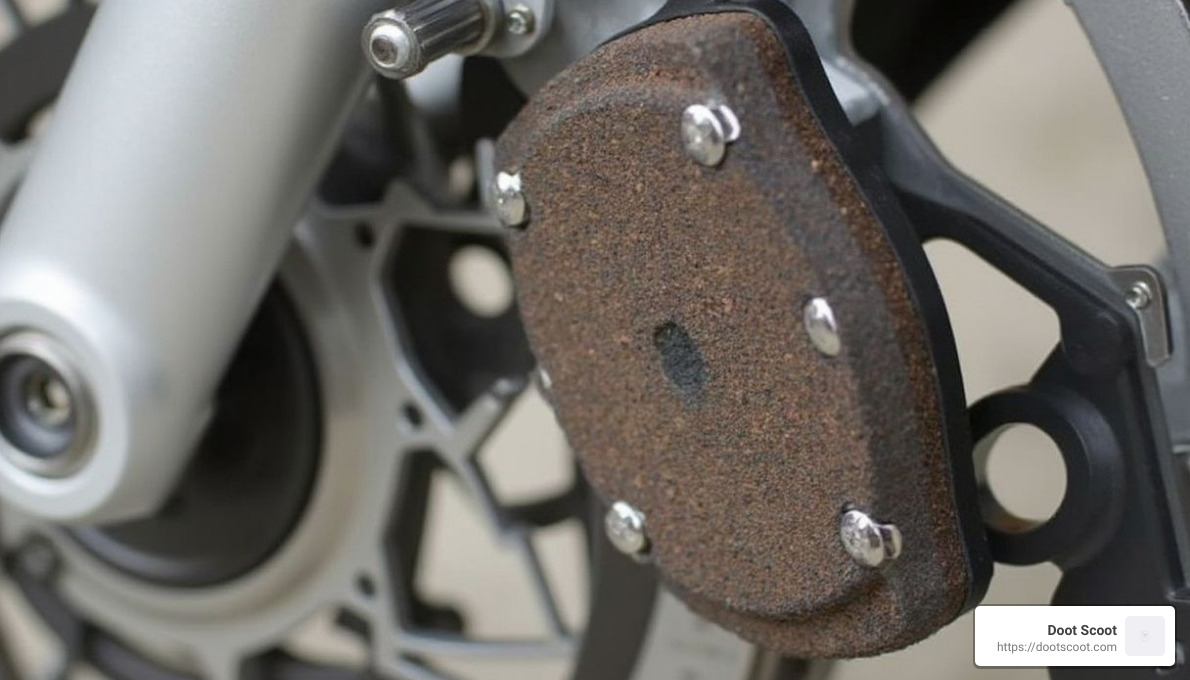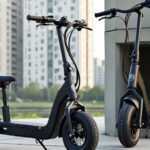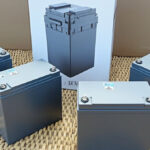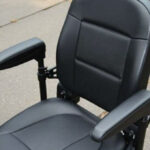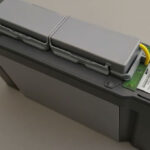Scooter brake pads are a crucial component of your electric scooter, ensuring safety and reliable stops. When your scooter’s performance can mean the difference between a smooth stop and a dangerous skid, have a good understanding of your brake system.
- Function: Brake pads provide the friction needed to stop your scooter effectively.
- Safety: Well-maintained pads improve safety by ensuring consistent braking power.
- Replacement Time: Regularly inspect for wear and replace pads to maintain optimal performance.
In a world increasingly conscious of eco-friendly transport, electric scooters have become a popular choice for urban commuters. However, their safety relies heavily on well-functioning brake pads. Regular checks and timely replacements can prevent accidents and extend the life of your scooter.
As more people accept this sustainable mode of transport, understanding the dynamics of scooter brake pads will keep your rides not just exhilarating but safe.

Quick scooter brake pads terms:
Understanding Scooter Brake Pads
When it comes to electric scooters, brake pads are essential for ensuring your ride is both safe and smooth. Let’s explore the different types of brake pads and how they work within the braking system.
Types of Brake Pads
There are three main types of brake pads used in scooters: organic pads, semi-metallic pads, and ceramic pads. Each has its own characteristics and benefits:
-
Organic Pads: Made from materials like rubber and glass, these pads are softer and quieter. They offer a smooth braking experience but may wear out faster than other types. They’re a good choice for casual riders who prioritize comfort over performance.
-
Semi-Metallic Pads: These contain metal fibers, which make them more durable and provide better braking power. They’re ideal for riders who need more stopping strength, especially in challenging conditions. However, they can be noisier and may wear down the rotors more quickly.
-
Ceramic Pads: Known for their longevity and quiet operation, ceramic pads are made from ceramic fibers and bonding agents. They offer excellent braking performance and are less likely to wear down the rotors. They are typically more expensive but are a great option for those who want a balance of performance and durability.
How Brake Pads Work
Disc brakes are the most common braking system used in electric scooters. They work by squeezing the brake pads against a rotor attached to the wheel, creating friction that slows down the scooter. Here’s a closer look at how this system functions:
-
Braking System: When you apply the brakes, hydraulic or mechanical force pushes the brake pads against the disc rotor. This friction generates the stopping power needed to safely halt the scooter.
-
Regenerative Braking: Some electric scooters feature regenerative braking, which uses the motor to slow down the scooter. This system not only helps in braking but also recharges the battery. However, it works best in conjunction with traditional brake pads for effective stopping.
-
Wear and Tear: Over time, brake pads wear down due to the friction they create. Regular checks are essential to ensure they haven’t thinned out too much, which could compromise braking power.

Understanding these components and their roles will help you maintain your scooter’s braking power. Regular maintenance is key to ensuring your scooter remains safe and responsive, providing you with peace of mind on every ride.
Next, we’ll explore when you should consider changing your scooter brake pads to keep your rides smooth and secure.
When to Change Your Scooter Brake Pads
Knowing when to change your scooter brake pads is crucial for maintaining safety and performance. Regular checks and understanding the signs of wear can prevent accidents and ensure a smooth ride.
Signs of Wear
Brake Noise: If your scooter starts making a squealing or grinding noise when you brake, it’s a sign that the pads might be worn down. This noise occurs because the pads have thinned out, causing the metal backing to make contact with the rotor.
Reduced Braking Power: If you notice that your scooter isn’t stopping as quickly as it used to, it might be time to check the brake pads. Worn pads reduce the friction needed to stop effectively, which can be dangerous.
Visual Inspection: Regularly inspect your brake pads for wear. Most pads have a wear indicator, a small notch that shows how much material is left. If the pad material is level with this notch, it’s time to replace them.
Recommended Replacement Intervals
Mileage: Generally, scooter brake pads should be replaced every 200-600 miles. However, this can vary based on how often and aggressively you ride.
Usage Factors: Riding conditions can affect how quickly your brake pads wear out. Frequent stops, riding in wet conditions, or carrying heavy loads can all lead to faster wear.
Front vs Rear Brakes: The front brakes typically handle more stopping power and may wear out faster than the rear brakes. Keep an eye on both, but pay special attention to the front pads.
Brand Differences: Some brands offer longer-lasting pads due to better materials or design. It’s worth investing in quality pads for better durability and performance.
Regularly checking your scooter brake pads and understanding these signs of wear will help keep your scooter in top condition. In the next section, we’ll guide you through the process of changing your brake pads, ensuring your scooter remains safe and reliable.
How to Change Scooter Brake Pads
Changing your scooter brake pads might seem daunting, but with the right tools and a little patience, you can do it yourself. Here’s a step-by-step guide to help you through the process.
Preparing for the Change
Before you start, gather all the necessary tools and set up a safe workspace. Here’s what you’ll need:
- Tools: Allen wrench, screwdriver, pliers, and a torque wrench.
- Safety Gear: Gloves and safety glasses to protect your hands and eyes.
- Workspace: A clean, flat surface with good lighting. Make sure your scooter is stable and won’t tip over.
Safety Precautions: Always ensure your scooter is turned off and the battery is disconnected to prevent any accidents. Double-check that the scooter is stable before you begin.
Step-by-Step Process
-
Remove the Old Pads:
- Access the Brake Caliper: Locate the brake caliper, which houses the brake pads. You may need to remove a wheel or other components to reach it.
- Loosen the Caliper Bolts: Use an Allen wrench to carefully remove the bolts holding the caliper in place.
- Extract the Old Pads: Once the caliper is loose, gently pull it away from the rotor. Remove the old pads by sliding them out. Be cautious of any clips or springs that might be holding them.
-
Install New Pads:
- Position the New Pads: Slide the new brake pads into the caliper. Ensure they are aligned correctly with the rotor.
- Reassemble the Caliper: Place the caliper back over the rotor and secure it with the bolts. Use a torque wrench to tighten them to the manufacturer’s specifications. This ensures they are secure but not overtightened.
-
Test the Brakes:
- Reattach the Wheel: If you removed a wheel, make sure it’s securely reattached.
- Reconnect the Battery: Turn the scooter back on and test the brakes.
- Perform a Brake Test: In a safe area, gently engage the brakes to ensure they are functioning properly. Listen for any unusual noises and check that the scooter stops smoothly.

By following these steps, you can ensure your scooter brake pads are effectively replaced, keeping your rides safe and smooth. Up next, we’ll tackle some frequently asked questions about maintaining your scooter’s braking system.
Frequently Asked Questions about Scooter Brake Pads
How often should I check my brake pads?
It’s a good idea to check your scooter brake pads regularly, ideally every month or after every 200 miles of use. Regular checks can help you spot wear and tear before it becomes a safety issue. Keep an eye out for signs like unusual noises or reduced braking power, which can indicate that it’s time for a replacement.
What are the best brake pads for wet conditions?
For wet conditions, semi-metallic brake pads are often recommended. They provide better grip and performance in damp weather compared to organic pads. Semi-metallic pads are made with a mix of metals, which gives them a good balance of durability and braking power, especially in wet environments. Always ensure your brake pads are compatible with your scooter model before purchasing.
How much do brake pads typically cost?
The cost of scooter brake pads can vary based on brand and material. On average, you might spend anywhere from $10 to $30 for a set of brake pads. High-performance or specialized pads, like ceramic ones, can be more expensive. It’s important to consider both price and quality, as investing in good brake pads can improve your safety and the lifespan of your scooter.
Conclusion
At Doot Scoot, we’re all about making urban mobility simple, safe, and eco-friendly. Whether you’re cruising through the city or tackling your daily commute, having reliable scooter brake pads is crucial for your safety and the environment.
Our mission is to provide you with the best information and products to keep your e-scooter running smoothly. We focus on eco-friendly transportation solutions that not only reduce emissions but also improve your riding experience. As you ride, maintaining your scooter, especially the brake pads, is a step toward sustainable living.
We believe in offering top-notch customer support to guide you through every step of your e-scooter journey. Whether you need advice on choosing the right brake pads or assistance with a purchase, our team is here to help.
Explore more about our tools and services on our Doot Scoot Tools page. Let’s make every ride a smooth stop together!
